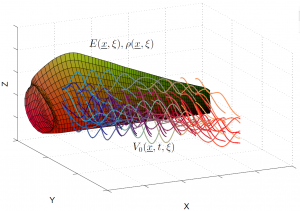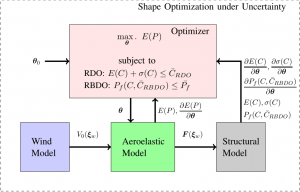Design Optimization under Uncertainty for Complex System
The design of engineering systems is typically dominated by high reliability and performance requirements. Conventional deterministic design approaches incorporate the effect of uncertainty in the design process via safety factors or worst-case scenarios that could result in conservative or insufficient designs. This deficiency can be overcome by incorporating probabilistic methods in the design process as done in the robust design optimization by minimizing the performance variation and reliability based design optimization by constraining the failure probability. One of the main intrinsic challenges however is the computational complexity of these approaches when applied to complex physical systems e.g. systems undergoing fluid-structure interaction (FSI). My research is primarily focused on building computationally tractable models that rigorously incorporate uncertainties in the design optimization and uncertainty management of such complex systems.
I. Engineering Applications
-
Topology Optimization under Manufacturing Uncertainty
Topology optimization has emerged as a powerful tool in designing vast variety of high performance structures from medical implants and prosthetics to jet engine components. While the subject of topology optimization has received considerable attention in the past two decades a majority of existing works assume deterministic parameters and conditions in the optimization process. However, the performance of a structure varies due to the inherent uncertainty in different parameters such as loading, boundary conditions and geometry. I have developed a systematic approach for topology optimization under uncertainty that accounts for spatially varying manufacturing errors. As an example, such errors are manifested in the form of under- and over-etching in the design of MEMS that influence the desired mechanical properties of the system. The approach utilizes a random field in conjunction with efficient non-intrusive Polynomial Chaos Expansion (PCE) to model the spatial variability. The non-intrusive PCE implementation is significantly facilitated via parallel processing due to its embarrassingly parallel nature. The optimized designs obtained from this approach are shown to be more robust and reliable than designs obtained from usual deterministic optimization.

Nominal design of a solid domain with circular holes
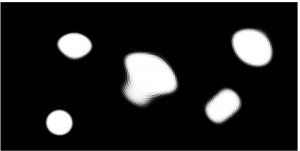
Distortion of the hole shapes due to spatially varying manufacturing errors

Topology optimized designs affected by different realizations of manufacturing uncertainty. The variation in bar thicknesses, indicating the geometric imperfection, is apparent.

Mean (left) and standard deviation (right) of element volume fractions. As expected standard deviation is more significant on the boundaries.
Reliability Based Topology Optimization rbdo_movie
Robust Topology Optimization rdo_movie
-
Shape Optimization under Uncertainty for Rotor Blades of Horizontal Axis Wind Turbines
Renewable energy sources deliver power with minimum impact on the environment. Among all renewable energy sources, wind energy is the fastest growing renewable energy source. This fast growth calls for development of larger scale wind turbines that are prone to more significant mechanical failures. Indeed, wind turbines operate in a hostile environment, and should be designed for uncertain loads due to the nature of the wind. I have developed a design optimization under uncertainy framework which integrates the reduced order turbulent wind model, the aeroelastic model of the wind turbine based on the Blade Element Method (BEM) and the reduced order finite element model of blade with efficient design sensitivity analysis under uncertainty. I used this efficient framework to determine the optimal shape of the blade that maximizes the generated power subject to reliability based and robust design constraints on the allowable compliance. The uncertainty propagation incorporates the Polynomial Chaos Expansion that facilitates the calculation of the output response given the input uncertainties such as wind and material properties.
A mapping from a 3D model of a wind turbine blade to a reduced order finite element model with random parameters under fluctuating wind forces.
The schematic overview of shape optimization under uncertainty. The
design optimization framework integrates the aeroelastic computations based on the blade element method with reduced order models of blade structure and wind.
II. Computational Methods Development
-
Gradient-Based Design Optimization under Uncertainty via Stochastic Expansion Methods
There are two levels of variation in optimization under uncertainty problems, namely variations in design parameters as well as variations in uncertain parameters that add to the computational complexity of the problem. The reliability and robustness measures are often estimated via Monte Carlo analysis or Taylor Expansion of the response function. It is obvious that the Monte Carlo approach is computationally prohibitive for large scale problems. The approximations based on Taylor Expansion are computationally efficient, however they are less accurate than estimates based on polynomial chaos expansions. Unfortunately, the polynomial chaos approach involves significant computational costs and incorporating PCE in usual population based optimization algorithms further increases this computational expense. As part of my postdoctoral research, I have focused on efficient computational methods for design optimization under uncertainty with the emphasis on the optimization algorithms. To that end, I have derived design sensitivity expressions with PCE. This work which serves as a systematic methodology for evaluating design sensitivities in the presence of uncertainty, enables the use of efficient gradient-based optimization algorithms for both reliability based design optimization and robust design optimization.
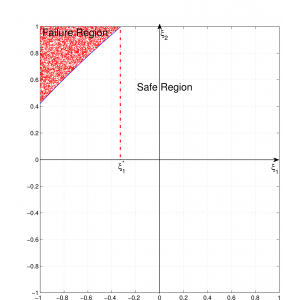
Polynomial Chaos Expansion (PCE) facilitates the characterization of failure region and estimation of failure probability and its sensitivity thus enabling the use of efficient gradient based optimizers for design under uncertainty
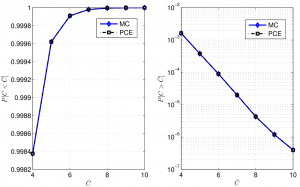
PCE with limited number of simulations (e.g. < 100 simulations) predicts the tail of limit state distribution as accurately as a Monte Carlo (MC) analysis with large number of simulations (e.g. 10^5 simulations)
-
Convergence Acceleration of Polynomial Chaos Solutions via Sequence Transformation
Significant computational challenges are associated with the polynomial chaos approach for problems with high dimensional parameter spaces. Efficiency and error analysis issues related to polynomial chaos solutions are subjects of much active research. The focus in many of these works has been on adapting the approximating stochastic bases to the problem at hand by relying on various error estimates. I have addressed this challenge by developing a novel methodology for convergence acceleration of polynomial chaos-based stochastic Galerkin solutions that does not require modifications to the approximation basis. Rather, I adapt nonlinear sequence transformations to the pre-computed approximations to increase their accuracy beyond existing methods.
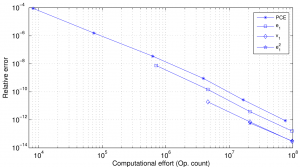
The Shanks (e1 and e1^2) and Levin (v1) sequence transformations accelerate the convergence of polynomial chaos coefficients. For a target relative error the computational effort required for these transformations is less than that of PCE. Similarly for a fixed computational effort these transformations yield smaller relative error.
-
Identification of Discontinuous Nonlinear Systems via a Multivariate Padé Approach
In addition to uncertainty effects, nonlinear effects have to be considered in the characterization of complex physical systems. This is specially true in system identification research for damage detection, condition assessment, control and health monitoring of engineering systems. I have investigated the identification of nonlinear systems that exhibit highly nonlinear or discontinuous response. Such systems preclude the use of standard polynomial representations in response surface methods. To remedy this, I use multi-dimensional Padé-Legendre representations (a rational representation with Legendre polynomials) to better characterize the nonlinear systems.
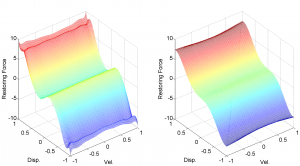
The response surface predicted by standard orthogonal polynomials exhibits spurious noises known as Gibbs phenomenon (left), the Padé rational representation mitigates the Gibbs effect in prediction of the same response surface (right).

